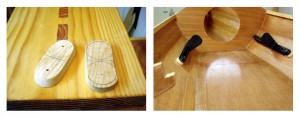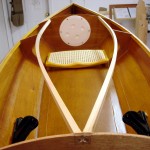(1st of 3 postings today) Do you follow directions step by step, exactly as written, no deviations? No, I didn’t think so. Does anyone? Sometimes it works out easier to break stride and do work a different way. This is one of those cases.
Progress on the boat slowed as I did another project (to be detailed sometime), but it’s boat building time again. The last you saw, I was fitting carlins and a seat. I decided to hold off on the carlins and complete the fitting out of the cockpit. One reason: paint. While all the wood gets at least two coats of clear epoxy as a sealant, that’s not enough. Epoxy needs some extra UV protection, hence paint, varnish, or some other coating is also needed. The cockpit and the decks will be “bright,” in the case of my boats “workboat bright” not “yachty bright.” I use Cetol Marine for those surfaces. It is clear with an amber tint. Three very thin coats do the job well.
The Fiddlehead, another decked canoe, taught me that painting the cockpit after the deck is installed requires numerous maneuvers easily handled by someone with triple elbow and wrist joints. I don’t need to learn that lesson twice. As I started to install the carlins, I thought, “Whoa. Hold on. Fit out the rest of the interior stuff and paint it before letting the carlins and deck get in the way.”
 The
The  other interior fittings were footrests and the deckplates that comprise the hatches into the watertight / flotation / storage compartments. The only element requiring any real work was the footrests. As shipped, they are designed to be screwed in place with big ugly screws that pass through the hull. I’ve always shunned having any more holes than absolutely necessary in a boat’s hull. So, I made some mounting pads that glue to the inside of the hull, to which the footrests can then be fastened with screws.
other interior fittings were footrests and the deckplates that comprise the hatches into the watertight / flotation / storage compartments. The only element requiring any real work was the footrests. As shipped, they are designed to be screwed in place with big ugly screws that pass through the hull. I’ve always shunned having any more holes than absolutely necessary in a boat’s hull. So, I made some mounting pads that glue to the inside of the hull, to which the footrests can then be fastened with screws.
With few obstructions, the painting was quick. I’ve found the little 4 inch foam rollers to be very convenient for this work.
Bob,
The third photo is wonderful! It is great and hides the terrific amount of work you have put into it to this point.
Like you, I am always reluctant to drill through something, unless it is absolutely necessary. Will the footrests be just that, and see no stress? I pictured you pushing against them with all your might.
Al
Al,
The footrests do absorb considerable pressure, but not huge amounts. Their purpose is to help one keep paddling energy from being lost to slipping and sliding around. The one part not yet attached is a backrest. So, the backrest and the footrests share the job of keeping a body immobilized.
Fastenings for the footrests are screws that pass through the rails into the wood pads. The pads are ash and I don’t see them splitting, nor do I see the epoxy bond failing. The screws have enough bite that their resistance to shearing should also be sufficient.